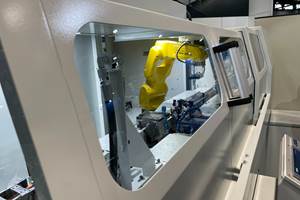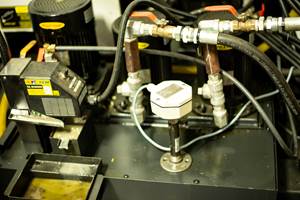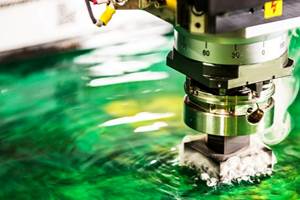How to Capture Liquid Smoke
Liquid smoke is the most difficult byproduct of a wet machining operation to capture.
Liquid smoke is the most difficult byproduct of a wet machining operation to capture. Although smoke is typically thought of simply as a dark cloud coming off a fire, the liquid smoke generated during wet machining is very different. Liquid smoke is created by processes that heat and/or compresses the coolant under high pressure, such as machining hard metals with straight-oil coolants. These processes produce a vapor that condenses back into a cloud consisting of liquid droplets measuring from 0.7 to 1.0 micron.
This is different from traditional machining mist, although both present health, safety and environmental risks if not properly captured. Mist, which can be created when using oil-based or water-soluble coolants, contains liquid droplets measuring as much as 20 microns in size (although these droplets can be smaller depending on how much heat and/or pressure is applied to the coolant). At 0.7 micron in size, liquid smoke droplets are almost 30 times smaller than average mist droplets, and capturing them requires a very efficient and well-thought-out mist collecting system.
First: Minimize Generation of Liquid Smoke
There are ways to minimize the amount of liquid smoke a process generates. One way is to cool the process. Because liquid smoke is often created by heat, cooling the process before the airstream reaches the mist collector gives the liquid smoke a chance to condense back into a liquid. This can be accomplished by simply drawing cooler air into the process airstream. It is recommended that the air is cooled to less than 105°F at least fifteen feet prior to reaching the mist collector. This ensures that liquid smoke does not condense after the mist collector, which might otherwise give the appearance of poor mist collector efficiency.
Slowing the airstream velocity within a system’s ducts may also enable liquid smoke to condense more fully prior to reaching the mist collector. Velocities of 2,500 feet per minute often provide sufficient time for more complete condensation. Slowing the duct velocity lower than this can be problematic, however, because mist can collect and pool in the duct. That said, providing a slight slope in the ducts helps minimize “pooling.”
If smoke is still exhausting from a mist collector even after the above modifications are in place, a more focused effort on final filtration may necessary. And the correct approach depends on the amount of liquid smoke being emitted. If considerable liquid smoke is generated, a multi-stage mist collector may be the best solution. Conversely, lighter amounts of liquid smoke may simply require an after-filter following the mist collector’s primary filter.
Second: Consider After-Filter Choices
Two types of after-filters are commonly used in wet machining applications: HEPA and 95-percent DOP filters. HEPA filters deliver 99.97-percent efficiency on materials measuring 0.3 micron in size, but offer limited filtration holding capacity. A 95-percent DOP filter can achieve five times the life of a HEPA filter, but it offers only 95-percent efficiency on 0.3-micron-sized materials. This is often acceptable, however, because most liquid smoke droplets average 0.7 micron in size. A 95-percent DOP filter might be 98- to 99-percent efficient for such droplets. Plus, this level of efficiency may enable air quality from a mist collector to achieve federal, state or local standards. In addition, a 95-percent DOP filter costs about the same as a HEPA filter even though it typically achieves longer life.
Third: Pick the Correct Mist Collector
If a wet machining process generates a significant amount of liquid smoke, the best option for economic operation is to effectively capture and remove the smoke prior to the after-filters. Therefore, it is important to understand the efficiencies of common mist collection equipment in the industry.
A very common version is the centrifugal mist collector. Centrifugal mist collectors are generally small, relatively inexpensive and often require infrequent filter replacement. A typical centrifugal mist collector can offer roughly 98-percent efficiency on materials measuring 1 micron. This efficiency decreases as the size of the materials decrease. Because the average size of liquid smoke droplets is 0.7 micron, the efficiency of a centrifugal collector may not meet the standards, and an after-filter would be needed (many centrifugal mist collectors can be fitted with an after-filter). Centrifugal mist collectors also have limited airflow capacity, typically 500 cfm or less.
Barrier-filter mist collectors are another popular form of airstream filtration. These collectors typically consist of aluminum mesh screens for large, heavy mists, followed by a series of polyester-based panels or cartridges. When a process generates a significant amount of liquid smoke, a barrier filter can offer higher levels of filtration and airflow than centrifugal mist collectors. As an example, a cross-flow fiber filter enables dirty air to flow horizontally through the walls of the filter, causing collected mist to drain down the filter. This option can offer a filtration efficiency of 99.3 percent for materials measuring 1.2 microns with airflows up to 1000 cfm at 4 inches of external static pressure. These performance levels are difficult and expensive for centrifugal collectors to achieve. Plus, this collector design increases filter life and limits maintenance cost.
Although capturing liquid smoke can be challenging, a filtration solution will generally be within reach. Maintaining proper duct velocity, sloping ducts and lowering airstream temperatures inside ducts will help simplify liquid smoke filtration. Ultimately, the proper filtration system for a wet-machining process should yield a low operating cost as it removes the problematic material from the airstream.
About the author: Nick Welter is a district manager for Donaldson Torit.
Related Content
IMTS 2022 Review: Attention to Automation Extends Beyond the Robot and the Machine
The advance toward increasingly automated machining can be seen in the ways tooling, workholding, gaging and integration all support unattended production. This is the area of innovation I found most compelling at the recent International Manufacturing Technology Show.
Read MoreManaging Coolant with Skimmers, Refractometers and More
Bacteria-infected coolant harms machines and sickens machinists. Coolant management technologies like skimmers and automated systems counter this tendency.
Read MoreSTLE Hosts Co-Branded Tribology, Lubrication Events
The 2023 STLE Tribology Frontiers Conference and Tribology & Lubrication for E-Mobility Conference will provide attendees with two opportunities to share and learn the latest tribology and lubrication engineering science.
Read MoreOelheld Coolant Increases Metal Removal Rates
The odorless coolant is said to offer increased removal rates, lower electrode wear, excellent surface qualities, lower refill quantities and longevity to provide lower overall operating costs.
Read MoreRead Next
3 Mistakes That Cause CNC Programs to Fail
Despite enhancements to manufacturing technology, there are still issues today that can cause programs to fail. These failures can cause lost time, scrapped parts, damaged machines and even injured operators.
Read MoreObscure CNC Features That Can Help (or Hurt) You
You cannot begin to take advantage of an available feature if you do not know it exists. Conversely, you will not know how to avoid CNC features that may be detrimental to your process.
Read MoreThe Cut Scene: The Finer Details of Large-Format Machining
Small details and features can have an outsized impact on large parts, such as Barbco’s collapsible utility drill head.
Read More














.png;maxWidth=300;quality=90)










